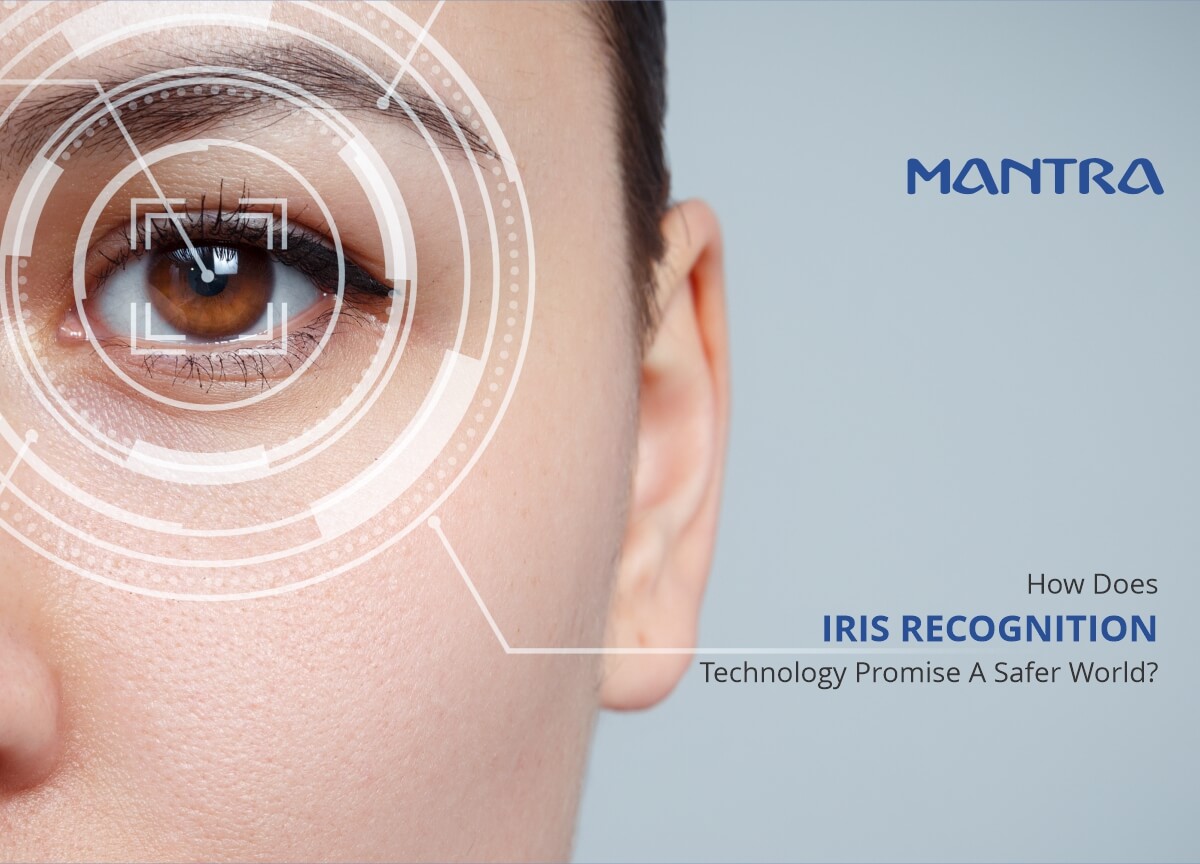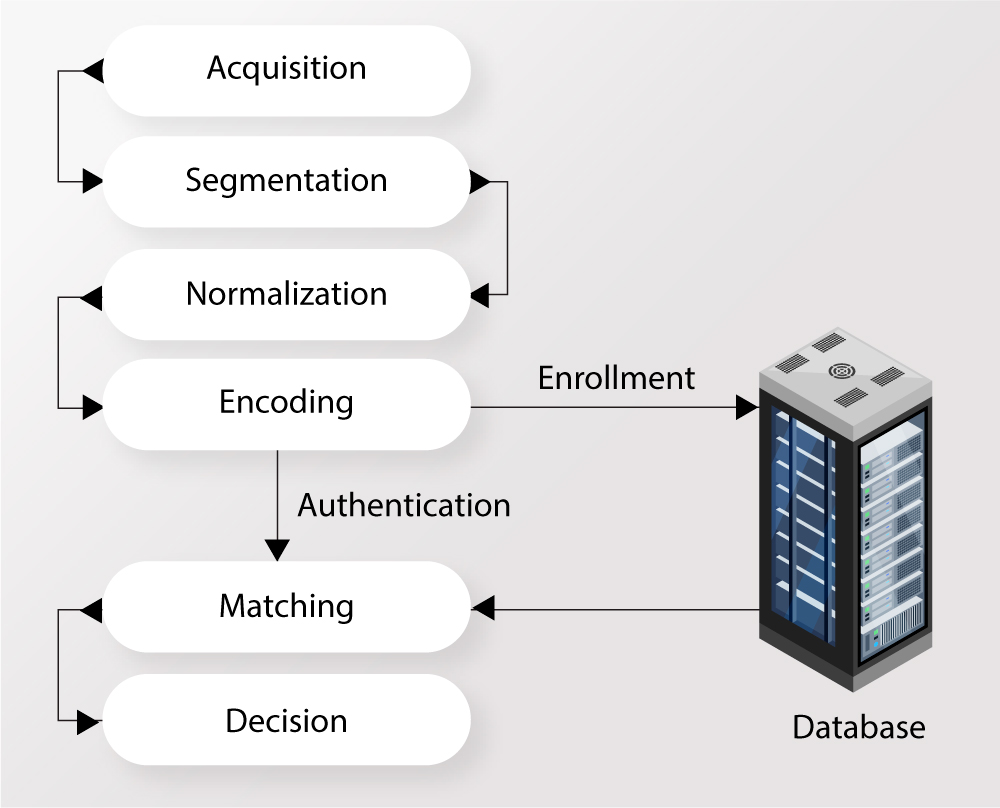
Biometric iris recognition technology has gained popularity as a robust identification and authentication solution in recent years. According to markets & markets, the global iris recognition size was at USD 2.3 billion in 2019. It is expected to reach USD 4.3 billion by 2024, at a CAGR of 13.2% during the forecast period. This data demonstrates how extensively iris recognition will be used as a contactless and robust authentication method for access control applications. Like all the biometric authentication methods, iris scanners read a unique behavioural feature of an individual; it detects the unique iris pattern of the human eye. Let us take a closer look at the biometric iris scanner, how it works, its benefits, and the areas where it is being used.
What Is Iris Scanner And How It Works?

Iris scanner is a device that captures the unique patterns of the iris by illuminating it with invisible near-infrared light. It detects around 250 biometric features of the iris and the amalgamation unique to every eye while excluding the eyelashes and eyelids. In addition, the iris pattern and colour is analyzed to extract a bit pattern that encodes all the information in the iris. This bit pattern is digitalized and compared to already stored templates in a database for verification (one-to-one template matching) or identification (one-to-many template matching).
The encoded structural features, or biometric templates, are stored in the biometric database at the time of enrollment of a person. When a person tries to authenticate, the system compares the iris sample of the person with the stored template in the database and grants access only if the match is positive.
Benefits of Iris Recognition
Iris recognition technology offers numerous benefits when used for identification and authentication purposes. These include:
Accurate matching: The strength of iris recognition lies in its accuracy. Its accuracy can be gauged mainly by factors; it has the lowest FAR & FRR, the iris pattern remains the same for decades, and the iris is an internal organ protected by the cornea.
Contactless Authentication: Considering the threat of the corona pandemic looming globally, the best advantage of iris recognition is that it serves the purpose in a contactless manner. A person does not need to touch any device. The scanner captures the iris pattern from a distance.
Spoof-Proof: With the evolution of fraudsters, an authentication process needs to be spoof-proof, and without any doubt, iris recognition is highly immune to fraud; because it is difficult to duplicate the complex iris pattern.
Versatility: Next-generation iris recognition technologies can scan human irises and animal irises with utmost precision. Australia pioneered the concept of providing cattle insurance based on IRIS verification to ensure that insurance is delivered to the right cattle.
Where Are Iris Scanners Being Widely Used?
Applications of Iris scanner is being increased dramatically in a wide range of industries. Public and private sectors are integrating their existing security systems with iris authentication to robust their access control system and beef up their security system.
Finance and Banking
Banks and financial institutions crunch a large amount of financial data. Therefore, they must have solid authentication technology to make the financial operations and processes immune to fraud. Iris recognition scanners are being used and adopted by banks and financial firms to replace the traditional password-based systems.
The use of iris recognition expects to improve the standards of financial services as bankers will be relieved from the time-consuming customer onboarding process. This will give bankers ample time and opportunity to concentrate on other vital areas, such as customer service.
Healthcare
Like the banking and finance sector, healthcare facilities also witness many footfalls; therefore, it becomes crucial to establish a robust patient identification system to avoid any kind of confusion, fraudulence, and duplicate medical records.
Iris recognition can reduce the burden of healthcare facilities' administration, including tracking the patient registration, repetitive treatment, checkup arrangement and scheduling, ambulant treatment document and treatment, or passageways to different departments.
The significance of Iris scanner in healthcare would be incomplete, with mentioning its role in securing Electronic Health Records. Securing EHR with iris ensures that only the correct record is opened every time. It also removes the potential of someone impersonating someone else in order to take advantage of insurance benefits, and it safeguards individuals from being unintentionally victims of medical identity theft. Ultimately, it removes the chances of human error, especially for patients with the same name.
Citizen Identification
Enrollment is a first and critical step to ensure secure and reliable population registration and build a foundational identity infrastructure. Countries around the globe are relying on dual iris scanners to enrol their citizens. Countries like India are using the combination of the iris as we all fingerprint recognition to strengthen the process of enrollment, which will further help the government to ensure fair and transparent execution of various welfare schemes.
Immigration and border control
It goes without saying that securing borders and airports is paramount for every country. The countries like the US, Canada, Netherland and London have already implemented Iris technology backed authentication systems to prevent external threats enter their nation. Airports are the areas where people demand a high level of security and frictionless customer experience, and Iris scanning does both brilliantly. Deploying iris technology at airports, enables pre-approved international passengers to clear Immigration without a passport or other identity. Further, it is used to grant access to airport employees to restricted areas within airports.
Payment and Billing
With rise of digitalization, the world is now building a cashless economy. Retailers, restaurants and shopping malls are increasingly employing point-of-sale (POS) devices to make billing more secure and convenient. Integrating iris scanner with POS machine is an ideal solution to improve customer experience without compromising the security.
Future OF Iris Recognition Technology
Undoubtedly, Iris recognition had proved its signification in identification and authentication purposes. It has matured from possible to practical and delivering it all: reliability, convenience, and simplicity.The arrival of the corona pandemic only boosted its global demand due to its contactless nature. Therefore, the manufacturer and designers of the technology are making efforts to improve recognition in non-invasive scenarios by improving sensors and integrating with other modalities. These improvement will increase the convenience of working with the device, and at the same time, increase the level of protection of confidential data.
If you are looking for iris devices, either single lens or double lens, please visit us at: IRIS-Sensor or send your inquiry at: Inquiry-Form
Comments